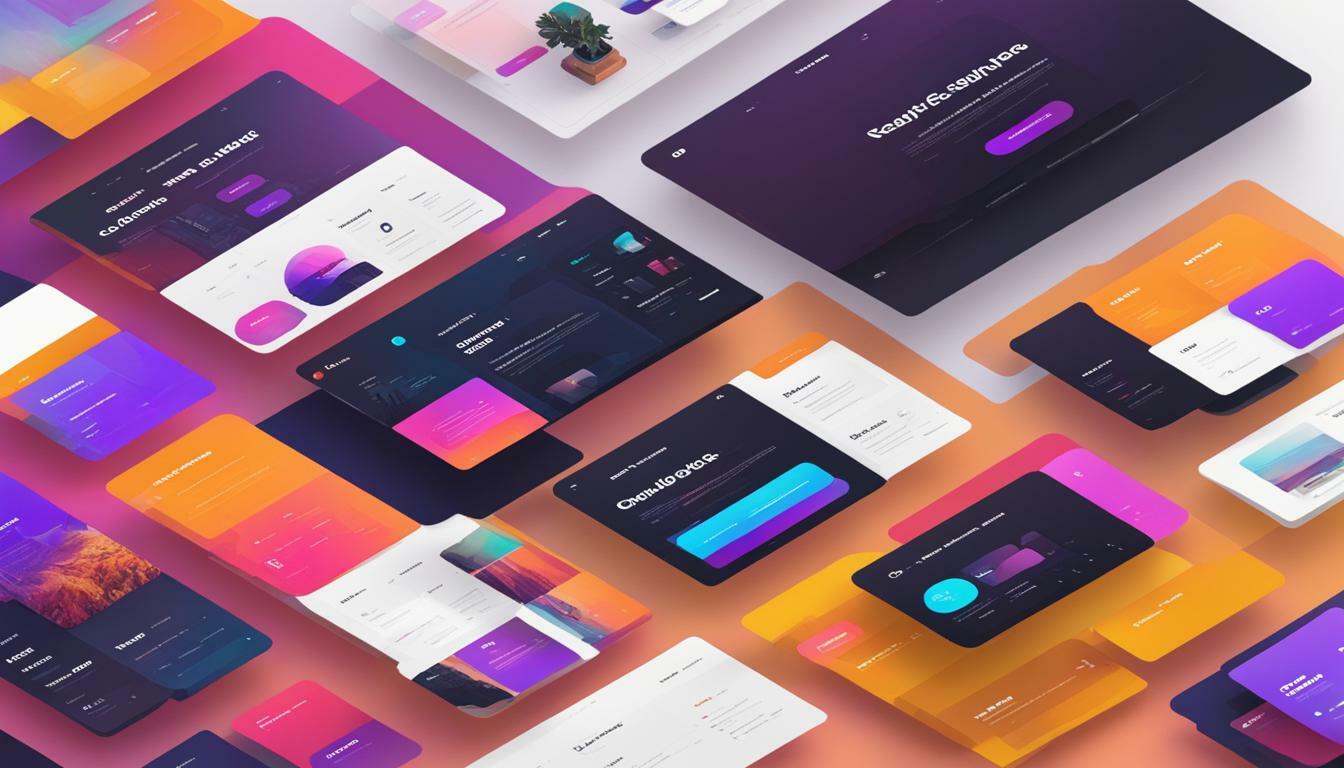Are you looking to design a stunning website that is functional, user-friendly, and visually appealing? Look no further than Figma, the powerful design tool that can help you achieve your website design goals. In this step-by-step tutorial, we’ll guide you through the process of designing a website using Figma, sharing valuable tips and insights along the way to ensure your success.
Key Takeaways
- Figma is a versatile design tool that can help you create stunning website designs
- Planning and organization are key to successful website design
- Wireframes provide a clear and intuitive user experience
- Figma offers a range of design elements to bring your vision to life
- Prototyping and collaboration are important for testing and refining your design
Understanding Figma: An Introduction to the Design Tool
Congrats, champ! You’ve decided to venture into the exciting world of website design using Figma. But first, let’s get acquainted with this powerful design tool. Figma is a web-based interface design tool that allows you to create beautiful designs for websites, mobile applications, and other digital products. The best part? It’s incredibly easy to use and perfect for teams who need to collaborate on designs.
Figma is packed with features that make it stand out as the go-to design tool for many designers. From vector editing to UI components and plugin libraries, this tool has it all. Plus, Figma’s cloud-based approach lets you work on the same project with other designers in real-time. Say goodbye to sending files back and forth and hello to seamless collaboration.
No matter your skill level, Figma is a design tool that everyone can use. Its intuitive interface and drag-and-drop functionality make it easy for beginners to jump right into designing while providing advanced features that satisfy the needs of seasoned designers. So, don’t be shy – give Figma a try and unleash your creativity.
Understanding Figma: An Introduction to the Design Tool
Now that you have a basic understanding of what Figma is, it’s time to dive deeper into all of its features. In the next section, we’ll walk you through the ins and outs of Figma, so you can start designing like a pro.
Planning Your Website Design: Key Considerations and Best Practices
Congratulations! You’ve decided to design your own website using Figma – a brilliant choice! Before you dive into the actual design, it’s essential to plan your website adequately. Here are some key considerations and best practices to keep in mind:
- Define your target audience: Who are you designing your website for? Ensure you understand their needs and preferences to develop a website that will appeal to them.
- Organize your content: Your website’s structure should be intuitive, so make sure to organize your content logically. For instance, group similar products or services together or divide your content into easily digestible sections.
- Keep it simple: Avoid cluttering your website with too many design elements or content. Instead, use white space and minimalistic designs to enhance your website’s clarity and focus.
- Mobile responsiveness: With more users accessing the web through their mobile devices, it’s essential to design a mobile-responsive website. Ensure your website looks good and functions perfectly on all devices.
- Call to action: What do you want your website visitors to do? Whether you want them to purchase a product, fill out a form, or subscribe to your newsletter, make sure your website has clear and compelling calls to action.
By keeping these best practices in mind, you’ll be well on your way to designing a website that not only looks great but also functions seamlessly. Don’t rush the planning stage – taking the time to plan will save you time and stress in the long run.
Creating a Wireframe: Sketching Out the Structure of Your Website
Now that you’ve planned out the important aspects of your website design, it’s time to start sketching out the structure of your site. This is where creating a wireframe comes in handy.
A wireframe is essentially a blueprint for your website. It helps you lay out the basic structure and layout of your pages, and allows you to get a feel for how your website will flow. A wireframe can be as simple or as detailed as you want it to be, depending on your needs.
When creating a wireframe, start by defining the basic structure of your site. Determine the primary navigation elements, such as the header and footer, and map out the different sections of your site, such as the main content area and any sidebars.
It’s also important to consider the type of content you’ll be including on your pages. Will you have a lot of text, or will you be using more visual elements like images and videos? Make sure you allocate enough space to accommodate your content without making your pages too cluttered or overwhelming.
| Tip | Don’t worry about the visual design of your website at this stage. Focus on creating a clear and intuitive layout. |
|---|
Once you’ve created a basic wireframe, it’s a good idea to get feedback from others before moving on to the visual design stage. Share your wireframe with colleagues or friends and ask for their input. They may be able to offer suggestions for improvements or help you identify any potential issues with your layout.
Tools for Creating Wireframes
There are many tools available for creating wireframes, ranging from simple pen and paper to specialized software. Here are a few popular options:
- Sketch: A popular design tool that includes wireframing features.
- Adobe XD: A dedicated design tool that includes wireframing capabilities.
- Balsamiq: A specialized wireframing tool that offers a wide range of pre-built interface elements.
Depending on your needs and preferences, any of these tools (or others) may be a good choice for creating your wireframe. Regardless of which tool you choose, make sure to keep your wireframe simple and easy to understand.
By creating a clear and easy-to-follow wireframe, you’ll be setting a strong foundation for the visual design of your website. So get sketching!
Designing Your Website: Bringing Your Vision to Life
Now here’s the fun part! It’s time to take all your planning and ideas and turn them into a visually stunning website. Figma offers a plethora of design elements to bring your vision to life. Let’s dive in!
First, let’s talk typography. Your website’s font choice is crucial in conveying your brand’s personality. It’s important to choose a font that’s easy to read and aligns with your brand image. Figma offers a wide range of fonts to choose from, so take your time and choose wisely.
The next design element to consider is color. Color has the power to evoke emotions and set the tone for your website. Take into account your brand’s color palette and choose complementary colors that will enhance your website’s overall look and feel.
Images and icons are also essential in website design. They help break up text and add visual interest to your site. Figma’s library of icons and stock photos will provide you with endless options to choose from.
When designing your website, remember to keep your target audience in mind. It’s essential to create a user-friendly website that aligns with their needs and preferences. Use Figma to create a beautiful and intuitive website that your audience will love.
Quick Tips:
- Choose a font that’s legible and aligns with your brand’s personality.
- Select complementary colors to set the tone for your website.
- Use images and icons to break up text and add visual interest to your site.
- Create a user-friendly website that aligns with your target audience’s preferences.
Congratulations! You’ve designed a visually stunning website. But before you launch it to the world, there’s one more important step: testing and refining. Let’s delve into the process of prototyping and collaboration in the next section.
Prototyping and Collaboration: Testing and Refining Your Design
Congratulations! You’ve now created a stunning website design using Figma. But before you pat yourself on the back and call it a day, there’s one crucial step left to take: testing and refining your design.
In this section, we’ll show you how to take advantage of Figma’s prototyping and collaboration features to gather feedback and make necessary adjustments to your design.
Prototyping Your Design
One of the most powerful features of Figma is the ability to create interactive prototypes. With Figma’s prototyping tools, you can simulate user interactions and test the usability of your design.
To create a prototype, start by selecting the frames you want to include and linking them together with interactive hotspots. You can then add animations and transitions to create a more realistic user experience.
Once your prototype is ready, you can share it with others to gather feedback. Figma makes it easy to collaborate with others in real-time, so you can get feedback and make changes on the fly.
Working Collaboratively
Speaking of collaboration, Figma is a great tool for working with clients or team members. With Figma’s cloud-based platform, you can easily share your design files with others and collaborate in real-time.
To collaborate on a design, simply invite your team members to the project and give them access to the necessary files. You can then work together to make changes and iterate on the design until it’s perfect.
Figma also keeps a complete history of changes, making it easy to roll back to previous versions if needed. This is especially useful when working with multiple team members, as it ensures that everyone is on the same page.
Testing and Refining Your Design
Finally, it’s important to test and refine your design before launching your website. Use your prototype to gather feedback from others, and make necessary adjustments to improve the usability and user experience of your website.
Figma makes it easy to refine your design, thanks to its powerful editing tools and collaboration features. Whether you’re working with a client, a team member, or just testing your design on your own, Figma has everything you need to create a stunning, user-friendly website.
So go ahead, put your design to the test, and refine it until it’s perfect. With Figma, the possibilities are endless!




